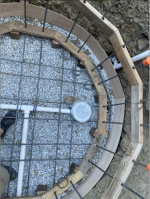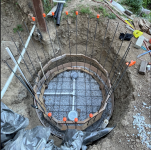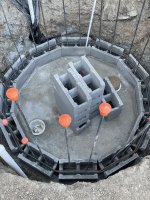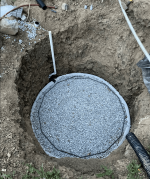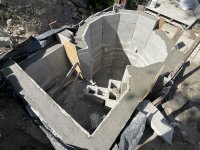Okay, concrete question, and a couple of updates.No way on a structural pour. I can mix a pallet in no time with a 2 bag mixer. You can't control the water mix in a tarp. Read about water and concrete and what happens to wet mixes
I got my Hayward drains, which I'm putting together now. I'm using 1.5" plumbing on a .5hp pump, as it's a small pool. The way the drains are designed, the middle of horizontally laid drain pipe is exactly 3" below the finished surface of the pool floor. I'm pouring a 6" thick concrete floor. The question is, do I put the rebar above or below the horizontally laid drain pipe?
I had originally bought 3" dobies to position the rebar, but that will put it at exactly center of the horizontal drain pipe. Doing some reading online, I saw several discussions about putting the rebar in the top 1/3 of the concrete to prevent cracking, but in the bottom 1/3 to increase structural load capacity. My rough calculation is the filled pool will weigh about 15,000 pounds, plus or minus 1,000 pounds. I'm assuming that means placing the rebar above the pipe is correct?
Update: Here's how I worked out my drainage issue.

So I dug this 7-foot deep hole into a hillside, where there's a mix of stone, clay and dirt. The hills here can slide if they get saturated, so I wanted to ensure good drainage. I bored a drain hole through the hillside to the downward slope, then put a French drain around the perimeter of the hole and in-filled with gravel--the concrete will end where the gravel meets the drain pipe, and I'll backfill the bottom of the hole with gravel after the walls are finished.
I also wanted to have a drain out for the pool. Originally, I planned to put a "t" in the pool drain to a valve where I could just open the valve to drain the pool. An engineer I respect a lot convinced me to keep it simple and not build in a way for the pool to drain on its own. So instead I installed a gravity drain into the outlet of the French drain. It will extend up to the level of the surface, and will be entirely outside the pool walls. I can then just drop a garden hose into the drain and siphon the pool dry if I want, or I can put a valve in the pump return pipe to use the pool pump to drain into the gravity drain. It'll all go into the main drain and down my driveway to the storm sewer.



